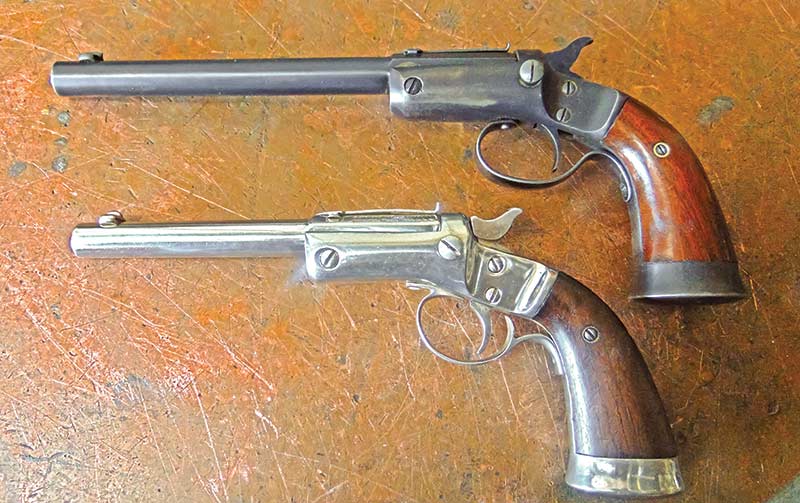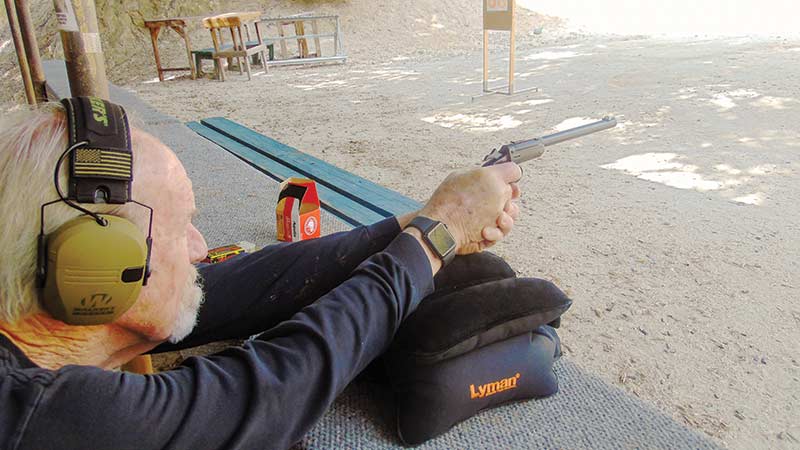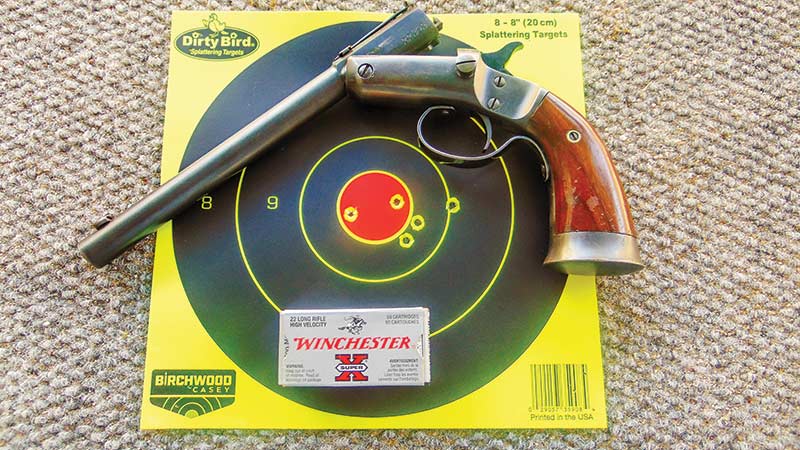Stevens No. 35 Offhand
Stone-Simple Single-Shot .22 Is A Golden Oldie
From its 1864 founding through its eventual 1920 absorption by Savage, the Stevens Arms Company was responsible for several signature creations — the Browning-designed Model 520 pump shotgun, the Stevens Favorite and Crackshot single shot rimfires rifles and, foremost among all, the .22 Long Rifle cartridge. In the early 1900s, the company even offered a fairly extensive line of “Stevens Rifle Telescopes.”
Single-Shot Stevens
But, aside from these noteworthy achievements, the company also offered a nifty array of single-shot pistols in .22 rimfire as well as long-barreled variants with detachable nickel-plated stocks euphemistically termed “Pocket Rifles.” As such, modern collectors should be aware these charming artifacts with barrel lengths under 16″ may attract the interest of the Bureau of Alcohol, Tobacco and Firearms. It’s best to check first in order to ascertain if they’ve been “grandfathered” in.
But the break-open single-shot pistols comprised much of the company output.
The specimen we were able to spend a day at the range with was the company’s final pistol offering — the Offhand No. 35 in .22 Long Rifle. Of course, it’ll also accept Shorts and Longs.
Ours featured an 8″ barrel from among the available 6″, 10″ or 12 ¼” models offered by the factory. Even with the 8″ tube, ours was still reasonably compact due to its abbreviated OAL. Thanks to its break-open design, the No. 35’s length was only an inch or so in excess of a 6.5″ Ruger Single Six revolver!
Kenneth L. Cope’s 1971 reference work, Stevens Pistols and Pocket Rifles discusses the Offhand and Offhand Target: “The Offhand No. 35 is identical to the Offhand Target No. 35 except for a stamped sheet metal trigger guard used after 1929. It was available from 1923 to 1929 in .410 smoothbore with the 12 ¼” barrel length … when discontinued in the early days of WWII, it was the last of the Stevens pistols.”
Mission Aborted
Our initial range session short circuited when several dry clicks indicated a broken firing pin. This necessitated an email to Jack First Gun Parts in Rapid City, S.D., for a replacement.
Once it was received and installed (a relatively painless operation), we returned to the range and started in on a series of 8″ targets set out at 20 yards. The trigger pull on our particular specimen proved delightful — a crisp and clean 3 lbs.
Unfortunately, the poundage required to cock the external hammer is far, far in excess of this figure. It requires a thumb like King Kong’s! I found myself using my weak hand to grasp the barrel to apply sufficient opposing downward pressure while my “not so strong” hand attended to the cocking chores.
Its intended purpose as an informal target gun notwithstanding, the Stevens Offhand rear sight is a small dovetailed V-notch arrangement with a step elevator. It’s not the optimum setup for older eyes, but it’s better in terms of visibility than a lot of handgun sights from the Model 35’s era.
Fire For Effect
From the 8″ barrel, the Aguila 60-grain Sniper Subsonic load chronographed 790 fps, which is about 160 fps less the load clocks from a rifle barrel. The Winchester 40-grain Power Point averaged 1,092 fps. This speed isn’t up there with a rifle, naturally, but it was still 288 fps faster than we got from a 3″ revolver. We even tried some 29-grain Winchester HV Shorts averaging 1,006 fps.
In terms of accuracy, the Winchester Power Point won out at 20 yards from a sandbag rest. Our best effort was a 5-shot 1 ¾” group with a 4-shot cluster of a hair under an inch. The runner-up turned out to be the Aguila heavyweight, which came in at 2″.
Our first few efforts showed a serious right-hand bias as far as windage goes. Fortunately, we had a brass drift to help remedy this — at least partially. Since pistol owner John Wrightman was with us, we didn’t want to get overly exuberant beating on the rear sight for windage adjustments.
As far as operational simplicity goes, the No. 35 Offhand makes a single-action revolver seem positively complex by comparison. Set the hammer at half-cock, press the receiver-mounted button on the left side of the gun, break the action, load the chamber, close the action, cock the hammer as best you can, aim and fire.
The pistol balances nicely in 8″ trim. The grip, incidentally, is fairly rounded in cross section, which may be a trifle disconcerting to today’s shooters, but it handles well.
After we were done with grouping and chronographing, we spent an enjoyable half-hour trying to break clay birds on a 40-yard berm. Amazingly, we managed a fairly good average.
All in all, the No. 35 Offhand was a pleasure to shoot. You can expect to part with $350 to $450 for one in nice shape, a bit more for an immaculate specimen. And with the price of ammo being what it is, spending an hour or so working your way through a box of ammo sounds like a pretty good idea.






